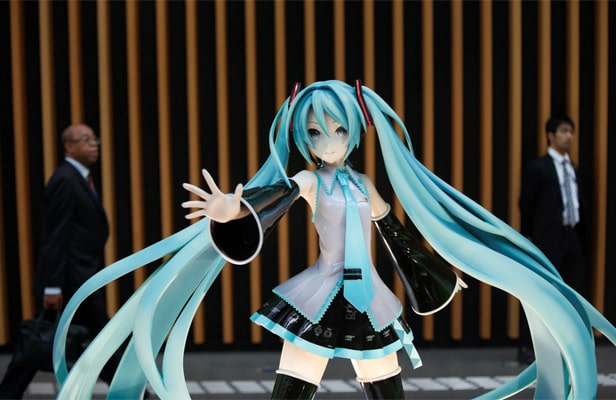The Virtual Lady Gaga - Imagine

PIXEL POP: The holographic anime pop star Hatsune Miku has become ubiquitous in Japan, even
appearing on the streets of Tokyo. (Reuters)
The world's most versatile performer is floating like a six-metre-tall ghost above the ranks of the Japan Philharmonic Orchestra and two banks of chamber singers.
Hatsune Miku's projected image trills a few lines from Isao Tomita's Symphony Ihatov, dancing delicately on top of the musicians, with a small kick here, a half-turn there, tilting her head from side to side.
She pirouettes like a ballet dancer, looks up to the sky, and drifts off the ground, slowly dissolving into nothing – a creative twist to a performer leaving the stage.
Miku might seem like nothing more than a high-pitched singing cartoon, but she's the spearhead and symbol of a radical cultural phenomenon.
Her anime-inspired avatar was invented to sell Yamaha's Vocaloid 2 voice synthesiser program launched by a company called Crypton Future Media (CFM) in 2007, which lets anyone construct a song from individual phonic units stored in a database.
You type the words into the program along with their mood, pitch and length. "Anybody can be a producer of Hatsune Miku," explains marketing director Kanae Muraki.
Miku's not the only Vocaloid character, but she's by far the most popular – her biggest hit, World is Mine, has 15.6 million hits on YouTube.
It's just one of an estimated 600,000 Miku works online, created by thousands of people.
The inspiration for this phenomenon struck when the Vocaloid's marketers relaxed copyright and offered a website where fans can remotely collaborate on songs and remixes.
In doing so, it created a space for "Vocaloids" such as Miku and others called Kagamine Rin and Megurine Luka, around which the culture could grow.
Another website gives fans the chance to choreograph their own Miku pop videos (there are more than 267,000 on YouTube alone). Miku has also appeared in an entirely computer-generated opera, The End, with costumes drawn by fashion designer Marc Jacobs, which will next be performed in Paris in November.
Miku might seem like nothing more than a high-pitched singing cartoon, but she's the spearhead and symbol of a radical cultural phenomenon.
The virtual singer has made $US120 million (NZ$145m) from 80,000 sales plus licensing – partners include Yamaha, Toyota, Sega, Google and Domino's Pizza – and has spawned a subculture whose members worship the art and music they collectively create.
"I won't say that Hatsune Miku could destroy the music industry," CFM head Hiroyuki Itoh has said, "but I feel like we are involved in something very new."
The biography for Hatsune Miku (which translates as "first sound of the future") is sparse. She's 16, 158 centimetres tall and weighs 42 kilograms. In an interview on YouTube, she says she likes singing, dancing, the colour green and leeks. That's pretty much it. "Miku is free like a musical instrument," an online comment declares. "She belongs to her users, there's no contract saying what, how, when she can sing."
"Miku is popular because she's the world's first wiki-celebrity," says Ian Condry, a cultural anthropologist specialising in Japanese popular culture at Massachusetts Institute of Technology. "Fans can participate in making her songs. It's as if you could write a song for Lady Gaga and she would sing it for you."
"She has no personality behind her save the idea of people," says An Ho, a 29-year-old from Australia now working in Japan as an English teacher. "The idea that a character can have whatever personality you choose for it allows for a wealth of creativity."
Miku's popularity – 10,000 tickets for four Tokyo shows sold out within hours for about $80 each last year – is evident at her concerts, where's she's projected in 3-D on to the stage and backed by human musicians. To get a better idea, just look on YouTube. A 2011 performance from the city of Sapporo opens with green glowsticks moving like a shoal of fish in the dark, thrusting into the air as one when Miku appears, miming playing a guitar. The stage is bathed in black, purples and reds, and rainbow lasers flash in the air. The crowd screams her name, though she'll never hear it.
"Miku shows a new potential for artistry, and I expect we'll see more experiments in collaborative creativity in the future," says Condry. "The traditional recording industry needs to reinvent itself. This is one of the paths emerging."
